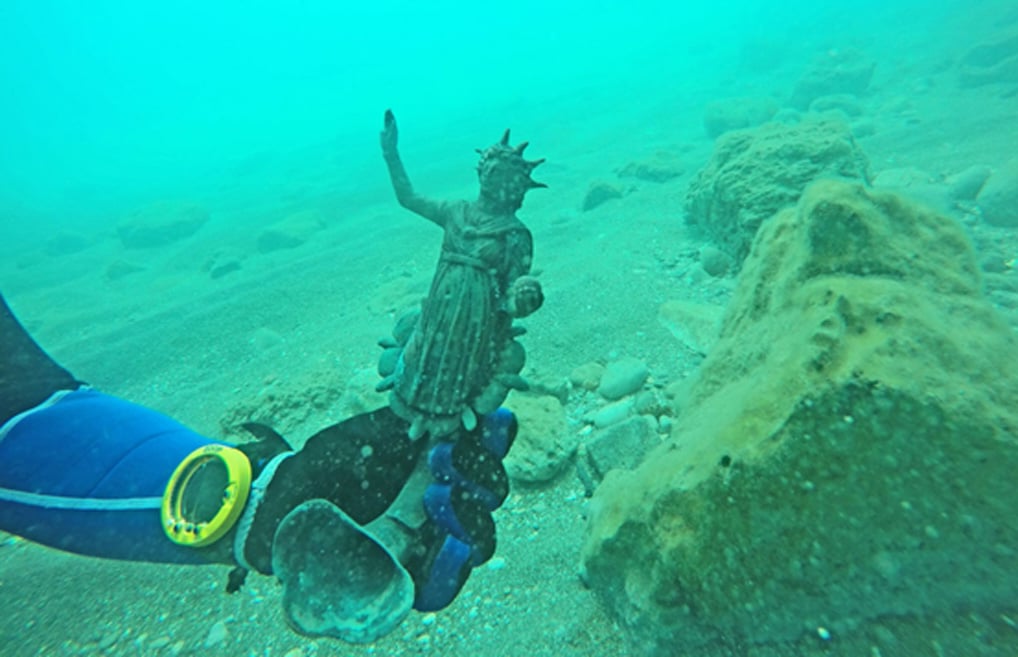1600-Year-Old Cargo of a Roman Merchant Ship has been Discovered in Caesarea
An underwater survey in the ancient port of Caesarea has uncovered thousands of coins and bronze statues dating to the 5th century AD.
The Greatest Catch
Two sports divers likely made their greatest catch in life when they made a fortuitous discovery of two Late Roman bronze statues in the ancient port of Caesarea.
As soon as they had surfaced divers Ran Feinstein and Ofer Ra‘anan
reported the finds to the Israel Antiquities Authority. During a joint dive, Ran and Ofer, guided marine archaeologists from the IIA to the location.
The seabead had been cleared of sand and a maze of iron anchors, moorings chains and debris were left exposed, being the remains of a ship.

The ship’s anchor as it was discovered in the sea. Photographic credit: The Marine Archaeology Unit of the Israel Antiquities Authority.
During the next weeks the IIA conducted an underwater salvage survey and in a relatively short time, they had recovered beautiful bronze statues, thousands of coins and other finds on the seabed dating to 5th century AD.
The treasure throw belonged to a Late Roman Merchant ships that sank in the harbor some 1600 years ago.
Wrecked by a Storm
Many of the artifacts are bronze and in an extraordinary state of preservation: a bronze lamp depicting the image of the sun god Sol, a figurine of the moon goddess Luna, a lamp in the image of the head of an African slave, fragments of three life-size bronze cast statues, objects fashioned in the shape of animals such as a whale, a bronze faucet in the form of a wild boar with a swan on its head.

Fragment of a bronze lamp decorated with the image of the moon god Luna, as discovered on the seabed. Photo: Ran Feinstein.

A lamp in the image of the head of an African slave. Photographic credit: Clara Amit, courtesy of the Israel Antiquities Authority.

Fragment of a life-size head of a statue. Photographic credit: Clara Amit, courtesy of the Israel Antiquities Authority.
In addition, fragments of large jars were found that were used for carrying drinking water for the crew in the ship and for transportation at sea. One of the biggest surprises in particular was the discovery of two metallic lumps composed of thousands of coins weighing c. 20 kilograms which was in the form of the pottery vessel in which they were transported.
“These are extremely exciting finds, which apart from their extraordinary beauty, are of historical significance. The location and distribution of the ancient finds on the seabed indicate that a large merchant ship was carrying a cargo of metal slated recycling, which apparently encountered a storm at the entrance to the harbor and drifted until it smashed into the seawall and the rocks”, said Jacob Sharvit, director of the Marine Archaeology Unit of the IIA, and adds,
“A marine assemblage such as this has not been found in Israel in the past thirty years. Metal statues are rare archaeological finds because they were always melted down and recycled in antiquity. When we find bronze artifacts it usually occurs at sea. Because these statues were wrecked together with the ship, they sank in the water and were thus ‘saved’ from the recycling process”.

The rare bronze artifacts that were discovered in Caesarea. Photographic credit: Clara Amit, courtesy of the Israel Antiquities Authority.
Coins carrying the Image of Constantine
The coins that were discovered bear the image of the emperor Constantine who ruled the Western Roman Empire (312–324 AD) and was later known as Constantine the Great, ruler of the Roman Empire (324–337 AD), and of Licinius, an emperor who ruled the eastern part of the Roman Empire and was a rival of Constantine, until his downfall in a battle that was waged between the two rulers.

Lumps of coins that were discovered at sea, weighing a total of c. 20 kilograms. Photographic credit: Clara Amit, courtesy of the Israel Antiquities Authority.
The range of finds recovered from the sea reflects the large volume of trade and the status of Caesarea’s harbor during this time, which was known as period of economic and commercial stability in the wake of the stability of the Roman Empire- the period when Christianity was on its way to becoming the official religion of the Roman Empire.
It was at this time that Emperor Constantine put a halt to the policy of persecuting Christians, and the faithful in Caesarea, as well as elsewhere in the Roman Empire, were given the legitimacy to practice their belief through the famous Edict of Milan that proclaimed Christianity was no longer a banned religion. Later, Constantine recognized Christianity as the official state religion, and it was during his reign that the fundamentals of the religion were established.
While the new finds are being studied by the IIA, a cache of gold coins that was discovered water off of Caesarea in the winter of 2015 are already being displayed to the visiting public in the Caesarea harbor.
By Sam Bostrom
Featured image: A figurine of the sun god Sol as discovered on the seabed. Photo: Ran Feinstein.




















Comments
Hi David, Thank you for pointing this out! The name has been corrected.
Thank you,
How is 'Luna' goddess of the Sun? Luna has always been descriptive of the moon. Come on guys.
This article needs to correct two assertions: 1.) Constantine never made Christianity the official State religion. Emperor Theodosius I did that in 380 AD. And 2.) Constantine did not "establish the fundamentals of the religion."
Not on that ship- but from the Greek depictions of Helios on coins and statues from Rhodes. The Romans copied the images and renamed them Sol.
We have a Greek sun god guarding New York Harbor.
http://usa.greekreporter.com/2014/12/26/the-colossus-of-rhodes-and-the-s...
So, that is where the French got the idea for the Statue of Liberty!
On that Roman ship!